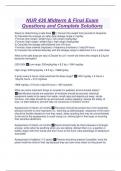NUR 436 Midterm & Final Exam
Questions and Complete Solutions
Steps for determining a safe dose ✅1) Convert the weight from pounds to kilograms
2) Calculate the average (or safe) daily dosage range in mg/day
-Formula (low range): weight (kg) x low range (mg/kg/day)
-Formula (high range): weight (kg) x high range (mg/kg/day)
3) Calculate the dosage administered over 24 hours
-Formula: dose ordered (mg/dose) x frequency (hrs/dose) x 1day/24 hours
4) Compare the ordered dose/day with the dosage range to determine if it is a safe dose
What is the safe dose per day of Zinacef for a 6- month-old infant who weighs 8.2 kg for
bacterial meningitis?
(200-240) ✅Low range: 200mg/kg/day x 8.2 kg = 1640 mg/day
High range: 240mg/kg/day x 8.2 kg = 1968mg/day
If given every 6 hours, what would be the dose range? ✅1640 mg/day x 6 hours x
1day/24 hours = 410 mg/dose
1968 mg/day x 6 hours 1day/24 hours = 492 mg/dose
What are some important things to consider for pediatric environmental safety?
✅Identification bands are essential, all windows should be secured, electrical
equipment needs to be away from water, small caps and objects put away, sturdy
furniture, crib sides should be up and secured, supine sleeping, assess the safety of
toys, no latex balloons, prevent falls, be conscious of infection control
Assessment of infants <6 months ✅The parent should be present but it isn't essential,
physical comfort is very important (i.e.: warming up stethoscope), sequence of the exam
should be flexible (based on how they react), delay anything that may be uncomfortable
to the end of the assessment to avoid crying (i.e. shining light in their eyes or touching
their sensitive abdomen)
Assessment of infants >6 months ✅Parent should really be there because of stranger
anxiety, smile when be soothing when you are talking, distract them (i.e. a pacifier or
bottle), begin with their hands and then move to the trunk, take advantage of sleeping to
auscultate
Assessment of toddlers (1-3 years) ✅Parents should be present if possible, have the
parent hold the child on their lap because they are now more reliant on the parent for
,comfort, approach them from behind, let them have a security item with them,
demonstrate the equipment on the parent first, observe for some of the exam (i.e.
seeing them walk or talk can tell you a lot), begin with their feet and then move up
Assessment of preschoolers (3-5 years) ✅Need willingness to separate and may
regress to stranger anxiety, leave underpants on until the end if checking genital area,
allow the child to touch and play with the environment, simple explanations, offer them
choices when you can, use distractions (i.e. naming colors or a book), for the sequence
you should base if off their preferences
Assessment of school age (5-12) ✅Usually very willing to cooperate, ask if they want
their parent to be present, provide modesty, teach them about their body and health,
head to toe sequence while offering choices/prepare them for each step of what you are
doing
Assessment of adolescents (12-18) ✅Maintain modesty because their bodies are
changing a lot, try to perform in a private area, head to toe sequence, ask them lots of
open ended questions to encourage discussion, assure them that the changes they are
going through are normal
Infants (1-12 months) vitals ✅HR while awake: 100-180bpm
HR while asleep: 75-160bpm
Respirations: 30-60
Hypotension: <70 systolic BP
Normal BP: 80--65
Toddlers (1-3 years) vitals ✅HR while awake: 100-150
HR while asleep: 75-150
Respirations: 24-40
Hypotension <70 systolic + 2x their age in years
Normal BP: 90--70
Preschoolers (3-6 years) vitals ✅HR while awake: 60-150
HR while asleep: 60-90
Respirations: 22-34
Hypotension <70 systolic + 2x their age in years
Normal BP: 95--75
School age (6-10 years) vitals ✅HR while awake: 60-110
, HR while asleep: 60-90
Respirations: 18-30
Hypotension <70 systolic + 2x their age in years
Normal BP: 100--75
Preteen/teens (>10yrs) vitals ✅HR while awake: 50-110
HR while asleep: 50-90
Respirations: 12-16
Hypotension <90 systolic
Normal BP: 110--85
oxygen adjunct numbers ✅- Nasal cannula - up to 5 L/ m
- Simple mask- 8-10 L/m
- Non rebreather - 10-15 L/m
Goals when analyzing an EKG rhythm ✅1) We want to identify the cardiac dysrhytmia
2) figure out how it is affecting our patient (ie: their cardiac output, stroke volume,
LOC/neurological status, activity level, vitals)
-Is the patient stable and just need monitoring or is this an emergency or a significant
change that requires a call to the physician?
3) question WHY did the dysrhythmia occur? What can be done to correct it?
EKG graph paper values ✅vertical axis is the amount of voltage and the horizontal
axis is time
Tiny box: 0.04 seconds
Larger box: 0.20 seconds
PR interval ✅The beginning of the P --> beginning of the QRS
Normal: 0.12-0.20 seconds (3-5 little boxes)
QRS interval ✅The beginning of QRS --> end of QRS
Normal: <0.12 seconds (<3 little boxes)
QT interval ✅The beginning of QRS → End T wave
Normal 0.36 - 0.44 sec




